Home | Front Page | Index | Blog | New | Contact | Site Map
Lake Peten Itza
Tikal
Coban
Guatemala City
Lake Atitlan
Markets
Antigua
Rio Dulce
Esquipulas
Mundo Maya
Foto Show

Central America
Route Maps
Belize
Honduras
Nicaragua
Costa Rica
Panama
Mexico 2003-04:
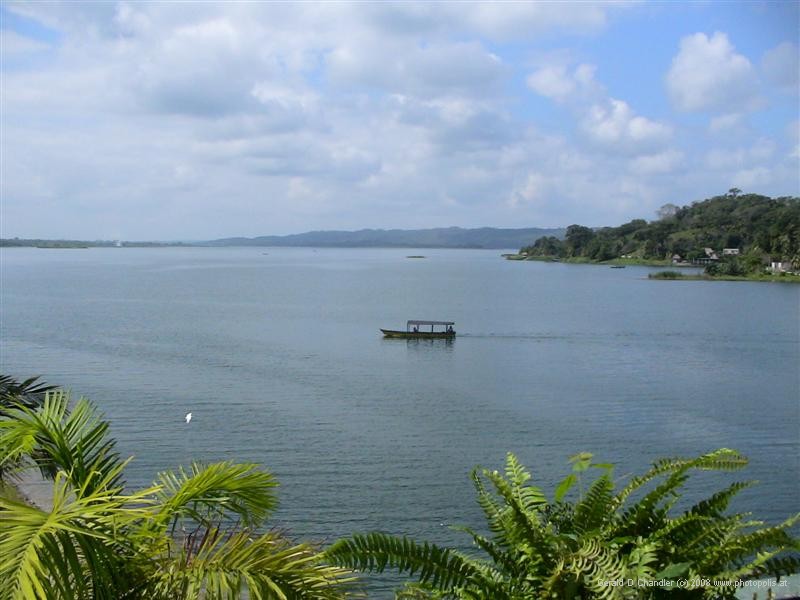
Lake Peten Itza |
After crossing the border from Belize, our first goal was the famous Mayan city of Tikal. Before touring it, we needed a hotel. Our choices were a hotel in the Tikal National Park (but the guide book said good luck if you don't have reservations); in the twin cities of Flores and Santa Elena (or triple cities if you count adjacent San Benito), but they would involve going an extra 35 km; or in the small village of El Remate, which is on Lake Peten Itza near where the highway divides for Tikal and Flores. We opted for El Remate and went to the Casa de Don David, whose flyer we had seen while in San Ignacio, Belize. It turned out to be a nice room in a place with lovely gardens and a fine view of the lake over which we watched the sun set.

Tropical Beauty |
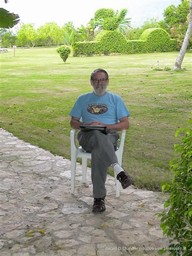
Gerry on his 62nd Birthday |
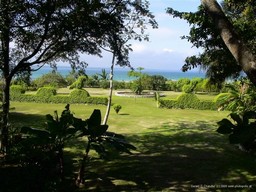
Casa de Don David's Garden |
We spent all of the following day at Tikal, the most impressive pre-Columbian site we have ever seen. Tikal sits in the far north of Guatemala, relatively near the Mexican and Belizean borders. Only twenty-five years ago did a paved road reach the ruins; until then archeologists came by horse or light aircraft. The site has a magical quality, probably very unlike it was when the Mayan elite had a major ceremonial center here. Now it is as much jungle as stone ruins, with wild howler and spider monkeys making their presence known by their calls, with coatimundi roaming the grounds, and toucans and other colorful birds inhabiting the trees and skys. From the highest temple one looks out and sees only the treetops of this jungle broken by the peaks of a handful of high stone memorial pyramid-temples. If you haven't seen it yet, you should not miss it.
After two days with Don David we decamped to Flores, 35 km away on the western end of Lake Peten Itza. Flores was once an island (and technically still is), and long ago, at the time of the Spanish conquest, was an important Mayan religious center crowded with tomb-temples. Sadly, the Spaniards destroyed them, and moderns ended the island's isolation by building a causeway with a short bridge. What remains is a half-mile diameter area with lots of hotels alongside plenty of locals who lead what seem to be "normal" lives. Our hotel provided us a balcony over the lake where we watched little kids swim, school kids come across from the shores of the peninsula opposite on their way to class, and a few tourists out in their rented kayaks. In the handicrafts shop on the top of the hill, just opposite the church, we saw some wooden carvings that qualified as some of the few things in Guatemala that we really wanted to buy. Our usual excuse, lack of a home and an overflowing storage locker, kept us and our pocketbook in check. But someday we'll come back...
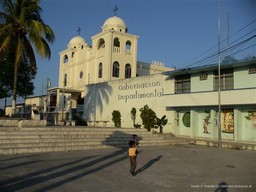
Main Plaza, Flores |
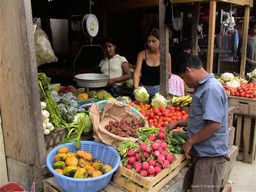
Fruit Market, Flores |
From Flores we took (and paid for) one of our few guided tours, a day tour by road and river 60 km south west to see the Mayan stelas of Ceibal. Our reluctance to take tours was overcome this time by the fact that the condition of the road was too bad for our small car. Either we took the tour or we didn't see Ceibal. Ceibal was once a giant city, even bigger, it seems, than Tikal. But the remains were rather underwhelming as almost none of it has been uncovered and reconstructed. The site was an amazing jungle world of tall, tall trees covered with mosses, wreathed with Tarzan-style hanging vines, and inundated with mosquitoes. On the river we saw two crocodiles (really, our boat man saw them and kindly stopped the boat for us), an eagle, and lots of other birds. On land we yet again had close encounters (but no sightings, alas) with howler monkeys and a fantastic view of a peregrine falcon perched pertly on a tree branch in a perfect position for viewing. Eat your heart out David Attenborough!
And then it was on to Coban, covering 20 kms over dirt road to get to the paved road, following the same route we had taken to get to Ceibal. At Sayaxche, instead of taking a small boat to Ceibal, we crossed the Rio Pasion on an aged ferry. Getting onto the ferry was no problem but on the other side it proved difficult. Jan needed help from two of the boatmen to urge the car up the steep slope of the bank.